Boat Maintaince
Know Your Boating Electrical ABCs
Artwork by velanoble.com
 Many sailors I know find their boat's electrical system daunting. The very same people who will tinker with practically every mechanical device on their vessel, will for some reason, shy away from the electrical side of things. Perhaps this view is shaped by those salty-dog authors who dismiss electrical systems as new fangled, and prefer stinky kerosene instead. Or perhaps, sailors have forgotten their high-school science, although it is hardly more complicated than Ohm's Law. Regardless, you have nothing to fear, as electrical systems are very straightforward and equally reliable when properly maintained.
Many sailors I know find their boat's electrical system daunting. The very same people who will tinker with practically every mechanical device on their vessel, will for some reason, shy away from the electrical side of things. Perhaps this view is shaped by those salty-dog authors who dismiss electrical systems as new fangled, and prefer stinky kerosene instead. Or perhaps, sailors have forgotten their high-school science, although it is hardly more complicated than Ohm's Law. Regardless, you have nothing to fear, as electrical systems are very straightforward and equally reliable when properly maintained.
Now to be clear, I'm talking about electrical systems, i.e., systems that supply electricity to your vessel. Electronic systems, i.e., all those nifty devices like chart plotters, auto pilots, AIS and TVs, etc., are another story.
A is for Alternator
Until someone invents compact nuclear reactors for yachties, alternators will reign supreme as the champions of nautical power, capable of generating far more electricity than all of your solar panels and wind turbines combined.
To understand this requires a dash of high-school science. Electrical power (P), which is measured in Watts (W), is the work done when an electrical current (I) of one Ampere (A) flows through an electrical potential difference (V) of one Volt (V), i.e., P = V*I. For example, 10A supplied by your 12V battery equals 120W of power.
Alternators rule in the onboard power stakes because they can produce large currents. For example, Arriba's twin Volvo Penta D1-30 engines come with 115A alternators, which at 12V, generate 1,380W (1.38kW) of power (each). In contrast, my solar panels produce a mere 200W. In practice, alternators typically only produce their rated currents for a few seconds, otherwise they would overheat; 50% of rated current is typical. Likewise solar panels only work for the 50% of the time when the sun is shining and suffer from further inefficiencies, for example, poor alignment with the sun or being shaded by a sail. As a result, I'm lucky to get 120W of solar power, i.e., 12V x 10A (P = V*I).
The alternator does its job by converting a portion of the considerable mechanical energy of your engine to electrical energy in the form of alternating current (AC). A device known as a rectifier, typically built into the alternator, converts the alternating current into direct current (DC). Horsepower is of course just another measure of power and 1hp equals 746W. Therefore each of Arriba's 29hp engines produces 21,634W of power (29x746), so the alternator's maximum 1,380W is barely 6% of the engine's power output (excluding losses).
Alternator technology, which dates back to the 1870s (not exactly new fangled), is time-tested and proven but occasionally things can go wrong. The most common problems are: Loose or worn drive belt (which connects the engine to the alternator) Brushes (which provide electrical connectivity to the alternator's rotor, i.e., the rotating field winding) Connections (more on this topic later) Rectifier (which produces DC from AC) or regulator (which regulates the output voltage) Alternators fail by producing either too little voltage, i.e., undercharging, or too much voltage, i.e., overcharging. The former means you'll never recharge your batteries and the latter means you'll damage them. An inexpensive multimeter is all you need to determine what is happening. Fire up the engine and measure the voltage across your starter battery terminals. You should measure approximately 14V at the battery terminal. If the voltage is under 13V or over 15V you have a problem.
In my case, and what prompted me to write this blog post, Arriba's starboard alternator recently started acting up. At first the alternator (battery charging) alarm only came on sporadically and then only for very short periods. So I went down the list above, checked the belt, replaced the brushes, etc. Eventually, the problem worsened to the point where the alarm sounded whenever I fired up that engine. So it was time to uncover the battery bank and break out the multimeter (which I should have done at the very outset). The problem was readily apparent when I measured a whopping 15.8V, incriminating the regulator.
Because I'm spoiled and I like to park Arriba with both engines, and because I had the luxury of a working alternator on my port engine, I simply disabled the starboard alternator. (Do you have cat envy yet?) You can disable an alternator by simply disconnecting the exciter (or magnetization) wire, usually designated as the 61, 61+ or D+ terminal. Alternatively, simply remove the brushes. An even more heavy-handed solution is to remove the drive belt completely, but check that you're not also inadvertently disabling your coolant pump. Never remove the BAT+ (B+) cable connecting the alternator output to the positive terminal of the battery though, since running the alternator open circuited creates a voltage surge that will fry the regulator. For the same reason, never switch off the batteries while the engine is running, unless the alternator has already been disabled.
Incidentally, the two other terminals found on an alternator are the BAT- (B-) terminal, which should be connected to ground, and optionally, a remote voltage sense (S) terminal.
In with the new alternator (left) and out with old (right).
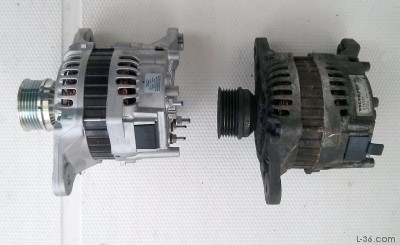 New alternator brush (left) compared to 50% worn brush (right).
New alternator brush (left) compared to 50% worn brush (right).
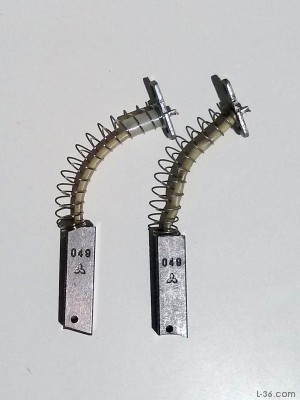
I installed a new regulator and plan to repair my old one and keep it as a spare. BTW, it's prudent to shop around. I found my replacement alternator on eBay for half the price that my local Volvo Penta dealer was asking.
One final tip for alternator maintenance. Your drive belt probably comes with a tensioner and instructions for the correct tension. Treat yourself to a proper belt tension tester like this. Gates 91132 Belt Tension Tester
B is for Battery
As everyone knows, a battery is a device which converts stored chemical energy into electrical energy. Different batteries utilize different chemical reactions to do their job, but lead-acid batteries, which have been around for 140 years, store the most energy per dollar and have the longest lives per dollar, and for these reasons they dominate automotive and marine applications. Battery Council International has this excellent tutorial if you'd like to learn more.
Battery energy capacity is measured in Ampere-hours (Ah). For example, a battery rated at 100 Ah, could nominally supply 5A for 20 hours, or 10A for 10 hours, or 20A for 5 hours. A word of caution though; routinely discharging batteries to below 50% of their rated capacity will damage them, so plan to use only half the rated capacity.
Traditional lead-acid batteries are not sealed and need to be topped up with water from time to time. Not a problem, just a hassle. Except there is a potential problem lurking, which is the underlying cause of the loss of water. Remember from high-school chemistry what happens when electrolysis breaks down water (H20)? Yes, Oxygen (O) and hydrogen (H) gas are produced. Even if they don't explode, who wants hydrogen wafting around? Remember the Hindenburg?
Fortunately, modern batteries can be sealed, which are technically known as valve-regulated lead-acid (VRLA) batteries. On Arriba I went with AGM (Absorbed Glass Matt) batteries both for my starter and house (deep-cycle) batteries.
What is interesting is how even very small voltage drops dramatically affect a battery's available capacity, or so-called state of charge (SoC). A lead-acid battery that is 100% charged at 12.65V, is 75% charged at 12.45V, 50% charged at 12.24V and fully discharged at 11.89V. Note that these voltages need to be measured when the battery is under load.
Last month, suspecting my batteries were on their way out, I took a couple of Arriba's house batteries to my local Battery World where they load tested them overnight for free. One was down from 100Ah to 40Ah and another to 15Ah. Clearly time for new batteries!
400Ah of new house batteries.
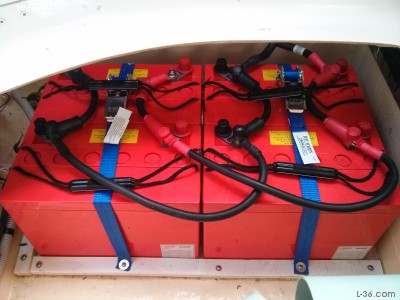 With AGM batteries, the only real care is ensuring that they are charged and floated at the correct voltage. For example, my new Ultimate UL100 AGM batteries, which are rated at 12.8V, should charge between 14.1V and 14.4V and float between 13.3V and 13.5V. Make sure you set your battery charger to the correct settings for your battery; don't assume your charger is smart enough to figure it out.
With AGM batteries, the only real care is ensuring that they are charged and floated at the correct voltage. For example, my new Ultimate UL100 AGM batteries, which are rated at 12.8V, should charge between 14.1V and 14.4V and float between 13.3V and 13.5V. Make sure you set your battery charger to the correct settings for your battery; don't assume your charger is smart enough to figure it out.
You may be wondering why a battery with a rated voltage of 12.65V or 12.8V should be charged at over 14V. The answer is that the alternator or charger has to generate sufficient voltage to overcome the internal resistance of the battery. The larger the voltage difference (potential) between the battery's voltage and the alternator or charger output voltage, the larger the charging current. Conversely, as the battery is recharged and the voltage difference decreases, the charging current also falls. For example, an alternator regulator set at 14.4V that delivers 50A to a half-charged 12V battery (or battery bank), will deliver 28A to a 75% charged one, and only 4A to one that is fully charged.
C is for Connection
Marine environments are really tough on electrical connections. It goes without saying that you should use high-quality electrical conductors that are properly sized, i.e., the right gauge for the job. However many electrical problems are due to poor connections, not poor conductors. Dissimilar metals connected that would likely last centuries in a dry environment, will start corroding immediately in a wet environment due to galvanic corrosion.
Now for some more high-school science, for the last time, I promise! Ohm's Law states that the current (I) flowing through a conductor is proportional to the potential difference (V) between its ends. It is usually expressed as V = I*R where R is the resistance of the conductor measured in Ohms.
A poor connection means higher resistance (R), which for a given current (I) means a larger voltage drop, which in turn means the electrical device at the other end, the "load", sees less voltage. For example, consider a battery voltage of 12.65V supplying 10A. If the conductor resistance (R) is 0.01 Ohms, then the voltage drop is a mere 0.1V, so the load sees 12.55V. If R is 0.1 Ohms however, then voltage drop is 1V and load sees only 11.65V.
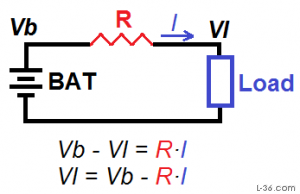 Excessive resistance also results in excessive heat, which may ultimately cause the connection to break down. For example, 10 Amps across 0.1 Ohm generates 10 Watt of heat!
Excessive resistance also results in excessive heat, which may ultimately cause the connection to break down. For example, 10 Amps across 0.1 Ohm generates 10 Watt of heat!
The most common connection problems are battery posts, battery connectors and alternator connectors, since these connections carry the largest currents. Check for corrosion and clean them if necessary. In particular, check the connection between the alternator BAT+ (B+) terminal and the positive terminal of the battery. As mentioned before, this is one connection you definitely don't want to have fail, since it will fry your alternator regulator.
When replacing my alternator, the ring connector on the smaller wire connected to the BAT- (B-) terminal was so brittle that it snapped in half with very little pressure. That terminal also had funky nut setup which was quite different to the one on my new alternator and I suspect the result of a dodgy repair in the past.
Broken ring connector previously connected to BAT- terminal.
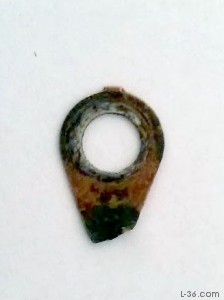 One final tip relating to electrical connections. Treat yourself to a proper crimping tool like this. HT-225D Full Cycle Ratchet Crimping Tool with interchangeable die set HT-225D
One final tip relating to electrical connections. Treat yourself to a proper crimping tool like this. HT-225D Full Cycle Ratchet Crimping Tool with interchangeable die set HT-225DIn summary, take the time to learn your boating electrical ABCs and you'll enjoy more time on the water and less time taking your boat in for a service.
OVER.
NOTICE: Some pages have affiliate links to Amazon. As an Amazon Associate, I earn from qualifying purchases. Please read website Cookie, Privacy, and Disclamers by clicking HERE. To contact me click HERE. For my YouTube page click HERE